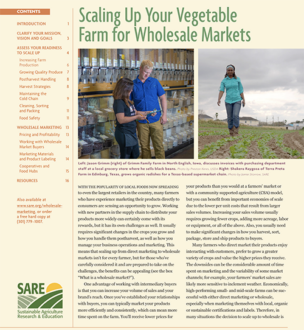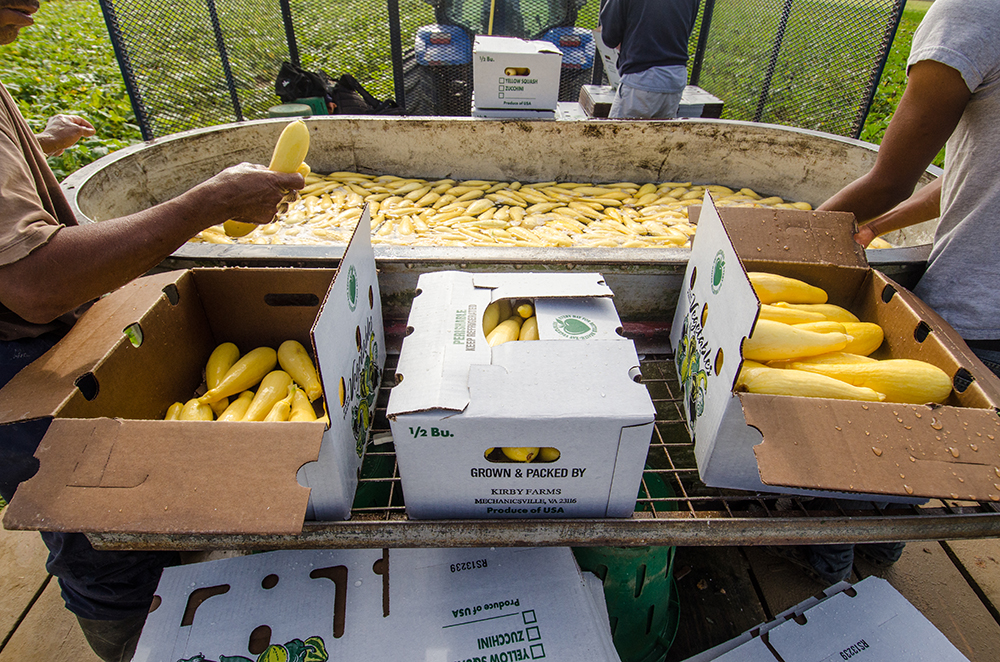
The intention with this guide is to offer a brief look at the key issues to consider when thinking about scaling up to wholesale markets. You’ll need to explore much further by carefully assessing your position, conducting market research and talking with knowledgeable professionals. As you go forward with planning, take time to speak with buyers to learn more about their specific requirements and how a relationship might work. Early on, seek out support and guidance from other farmers who have already scaled up successfully. Also, if the requirements continue to seem daunting, consider if there are opportunities to collaborate with other local farmers through cooperatives or aggregators. (See the section “Cooperatives and Food Hubs.”)
There are many good resources available at the state and national level to help you dive deeper into the issues related to selling into wholesale markets. See the “Resources” section at the end of this publication for a partial list to get you started.
The Wholesale Success guide, published by FamilyFarmed.org, provides the following summary of requirements for selling into wholesale markets, many of which may be unfamiliar territory for direct-market farmers:
- Cold chain. At harvest, you must remove the field heat from most crops using proper cooling. You must also maintain the “cold chain” from the field to the customer with refrigerated storage of most fruits and vegetables. It’s important to understand and meet the storage needs for each crop, including temperature, humidity and ethylene sensitivity to accomplish maximum shelf life.
- Uniform pack. You must sort products uniformly to match USDA grades and to pack them according to industry standards of quality and packaging.
- Food safety. On-farm food safety procedures are important. Some buyers may require food safety certification by a third party auditor.
- Volume and consistency. Plan succession plantings to provide consistent, quality product in the volume your buyer needs. Meeting buyers’ needs is key to a healthy long-term relationship.
- Relationships and communication. Build relationships with buyers and stay in touch regularly to communicate issues such as timing, quantity, price and quality.
- Choose wholesale market crops carefully. Before you plant, be absolutely clear on what the buyer wants in terms of specific cultivars, types of crops or quality characteristics. Then consider, are the crops you plan to grow likely to do well in your soils and climate? Can you manage the expected weeds, pests and diseases for these crops? What are the most labor-intensive tasks associated with these crops? Can you mechanize these tasks with a realistic amount of investment and without sacrificing quality?
Curriculum Materials for Educators
Extension educators who want to offer training to farmers on this topic can consider the Baskets to Pallets Training Manual, a comprehensive five-module curriculum developed by the Cornell University Small Farms Program, with funding support from SARE (https://smallfarms.cornell.edu/projects/baskets-to-pallets). The curriculum uses case studies to help participants understand real-life management, production and promotion strategies through the lens of wholesale marketing.
These requirements have implications that need to be fully and carefully explored. Do you have the resources, skills and interest in taking on this change? Michigan State University’s Center for Regional Food Systems provides a Market Channel Selection Tool to help farmers decide which direct market and wholesale channels might be best, based on characteristics about the farmers and their farms. According to the tool, some of the characteristics that might make larger-scale distribution right for you include:
- Farm characteristics. You’re able to produce large quantities of individual crops. You have high levels of experience (10 or more years), mechanization and access to acreage.
- Marketing/advertising. It isn’t important to you that people know their food came from your farm, and you aren’t particularly interested in interacting with consumers. You’re willing to put effort into managing customer/buyer relationships if you have to, even if you don’t enjoy it.
- Product characteristics. You’re content with minimal crop diversity on your farm, for example growing fewer than 10 crop types. You achieve excellent product quality and consistently high yields. You’re very willing to, or already have, met one level of food safety certification (e.g., GAP).
- Pricing. You prefer working with set prices and prefer to operate at high volumes and low prices, rather than insisting on getting the highest price for your products.
- Farm location. Proximity to large population centers isn’t important to you.
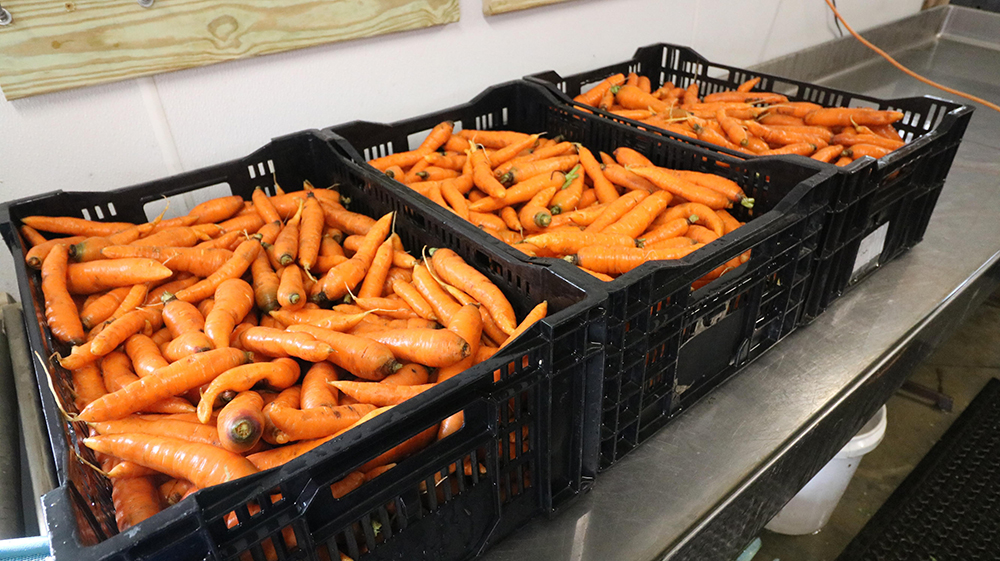
Access to the right kind of labor is another important issue to consider early on. Direct market channels and wholesale channels tend to have different labor requirements. For example, direct-market farms may have a higher need for sales staff, whereas farms in wholesale markets usually require more production and harvest labor. Production labor is increasingly a bottleneck for commercial growers. It can be valuable to have a labor needs assessment and management plan in place as you consider major changes, especially if you expect to hire H-2A workers.
You should also think about your tolerance for risk and how different market channels could cause you stress. All decisions involving market channels can create their own stress, so these are highly personal considerations to reflect on. For example, which of these situations might cause you more or less stress: running a small-scale operation versus a large one, growing 30–40 varieties of crops versus only a few, or committing to a CSA each year versus having a truckload of produce rejected? Be aware too that sometimes the stress of trying something new gradually diminishes as you gain experience.
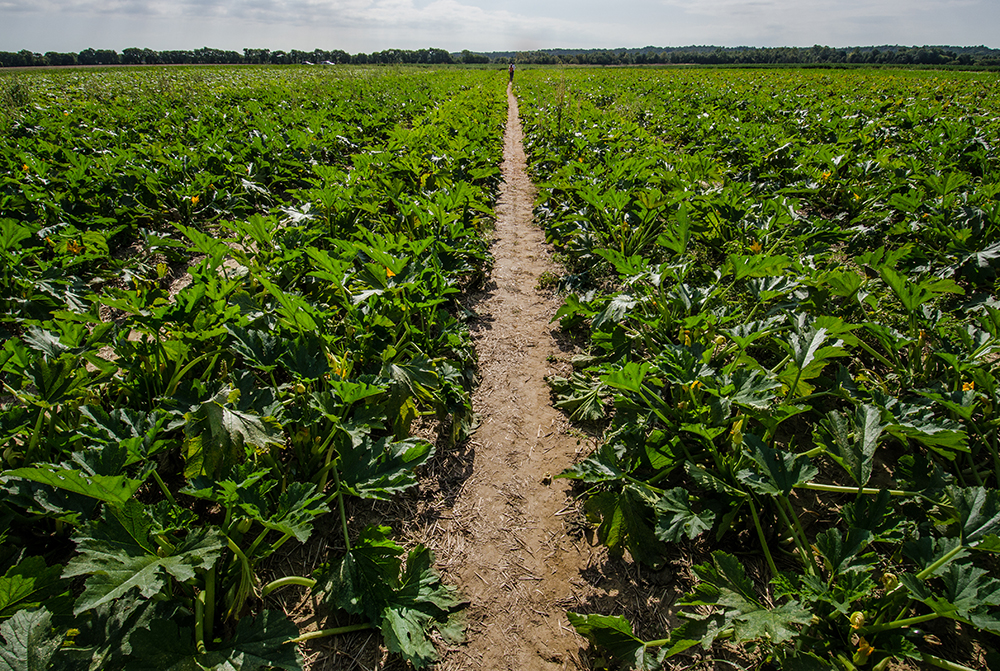
Increasing Farm Production
If you aren’t already there, you’ll need to make sure you can produce a large volume of high-quality products on a consistent basis. This is because wholesale prices are lower than direct markets, and these buyers require consistent supply and consistent quality. The usual ways to achieve this target are by focusing on growing fewer crops, expanding acreage, acquiring the right equipment, hiring needed labor and carefully fine-tuning your production system.
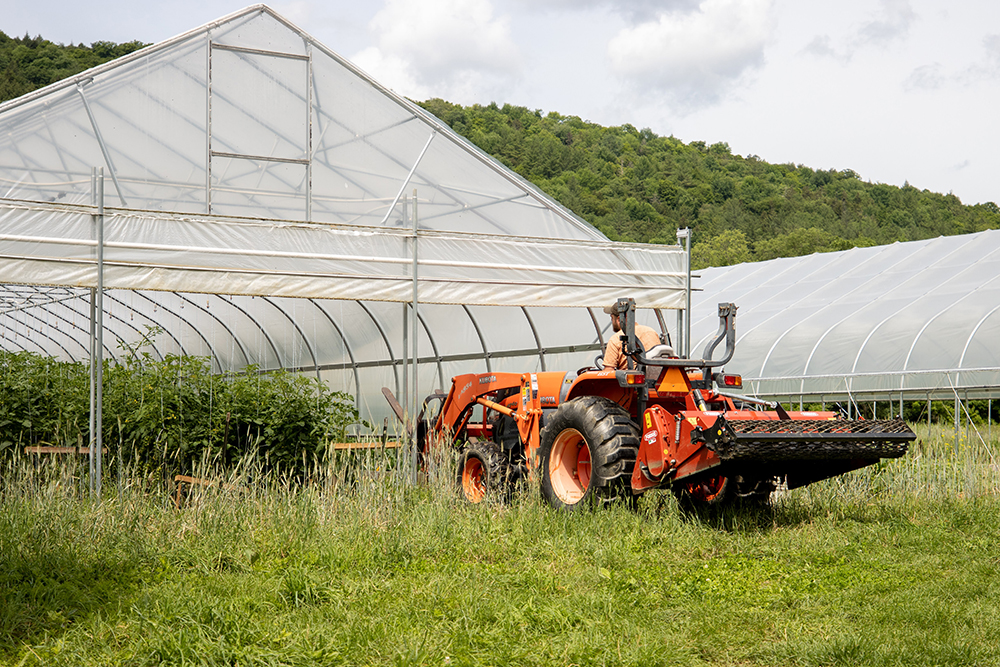
Since land can be a major limiting factor, look into it early on. Leasing is a good option if you have limited financing or if you aren’t sure you want to commit to larger-scale production in the long term, but you’ll need to carefully evaluate the condition of the land and quality of the soil before proceeding. If you know that expansion fits with your long-term goals, look into conventional loans or lower-cost FSA loans for buying the land you need. To receive financing you’ll need to prepare documents that outline the cash flow you expect to create from your planned growth.
Consider the full range of equipment you’ll need to grow, harvest, clean, sort, package, store and transport your produce (Table 1). This too can be an expensive proposition if you’re currently relying on hand tools and walk-behind tractors, or if you’ll need to scale up the size of your facilities or trucks to handle increased production volumes. If you’re seeking to scale up a value-added product that you process on farm, consider whether your processing facility can handle increased production, or if you’ll need to expand. Many state Extension programs provide information on partial budgeting, a strategy that helps you understand the financial impact of a proposed change to your farm. The University of Vermont’s Tractor Resource Hub (https://blog.uvm.edu/groundwk/tractor-purchase-maintenance) includes information on equipment purchasing.
| Table 1. Equipment options for a 20-acre vegetable farm1 |
|---|
| 50–75 horsepower tillage tractor with loader |
| 15–20 horsepower cultivating tractor |
| Pickup truck |
| Manure/compost spreader |
| Three-bottom plow |
| Three-shank chisel plow |
| Rotavator |
| Disk harrow |
| Field cultivator |
| Bed former or mulch layer |
| 6–8-foot seed drill (for cover crops) |
| Two-row tractor mounted plate or drill seeder |
| Two-row tractor mounted precision seeder |
| Two-row mechanical transplanter |
| Boom sprayer |
| Basket weeder |
| Spring tine cultivator |
| Set of cultivating sweeps, shanks, shovels, etc. |
| Flail mower (or brush hog) |
| Hand tools and wheel hoes |
| Irrigation lines, sprinklers, pumps, etc. (per acre) |
| Two-row gravity fertilizer side-dresser |
| One-row potato harvester |
| Root lifter |
| Harvest wagons |
| Wash tanks |
| Washing line and sorting table |
| Barrel washer |
| 2,000-cubic-foot walk-in cooler |
| Refrigerated delivery truck |
| Shop tools (welder, drill, grinder, compressor, etc.) |
| 1From Grubinger, V. 1999. Sustainable Vegetable Production from Start-Up to Market. Ithaca, NY: Plant and Life Sciences Publishing. |
When the Raygozas of Terra Preta Farm scaled up from 1.5 acres of diversified vegetables to a 15-acre wholesale radish operation, they made several key investments in equipment. Among those was a 25 horsepower tractor and several implements to plant and cultivate radishes, as well as to terminate off-season cover crops and prepare beds. In particular, adding a belly-mounted basket weeder to their high-clearance tractor after their first season of wholesale production was “a game changer,” according to the Raygozas. Not only did it eliminate the need to hire a crew for hand weeding, it allowed them to begin planting four rows of radish per bed instead of three. “We saved quite a bit of money just by adding that to our production,” says Shakera Raygoza.
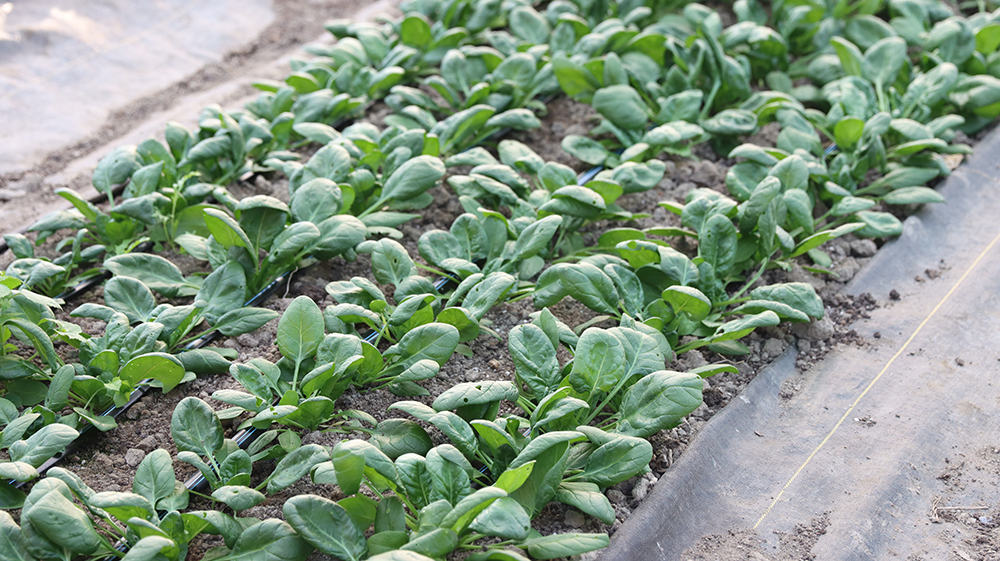
Along with making sure you have the right acreage and equipment, developing a well-organized system for your growing beds is critical to efficient and consistent production and harvest. Try to arrange the size and layout of your fields, beds and driving lanes to optimize efficiency in terms of equipment access, including harvest and postharvest equipment.
While you’ll need less labor in the areas of sales and delivery, you’ll likely need more help in the fields during the growing season—especially during harvest. Factor in this expense during your planning and reflect on how easy or hard it might be to find good farmworkers, and whether you have the capacity to hire, train and manage your staff effectively.
Growing Quality Produce
Wholesale market buyers will expect your produce shipments to be of consistently high quality. Rightfully, much emphasis is placed on the importance of best practices in postharvest handling in order to maintain the shelf life of products from the field through to the end customer. But at the same time, you’ll need to grow good crops in the first place so that they keep in storage and meet U.S. Grade Standards. Here are some examples of how farm practices can influence the quality of produce for the wholesale market:
- Soil and nutrients. A healthy soil is the foundation of a healthy, well-yielding crop, and of course, farmers who use organic practices such as cover crops and amendments of compost or manure are already prioritizing soil health. Manage nutrients carefully as well. Nutrient deficiencies can negatively affect the color, texture, taste or nutritional content of produce, and can lead to disorders during storage such as rot or discoloration. High levels of nutrients such as calcium and potassium play an important role in favorable vegetable qualities, but excess levels of some nutrients can lead to problems, such as excess nitrogen causing increased soft rot in stored tomatoes or increased weight loss of stored sweet potatoes.
- Water management. Irrigate in a timely manner to meet an individual crop’s needs and avoid over or under watering, either of which can negatively affect harvested crop quality. Avoid harvesting fungal-sensitive produce such as crops in the solanaceous (tomato, potato, pepper,eggplant) and cucurbit families (cucumber, melon, squash) when it’s wet or dewy. This can cause disease in the field and impact produce storage life. Surface or subsurface irrigation can help prevent this issue. Harvesting leafy greens, broccoli and cauliflower during rainy periods or when morning dew is present doesn’t affect crop quality or storage.
- Pest management. Insect pest problems during the growing season can result in visible damage to crops that makes them unappealing and prone to disease. Also, pests that are present on harvested crops can proliferate in postharvest storage.
- Crop and variety selection. Focus on crops that grow well in your climate and soil conditions, and that make sense for the amount of acreage you have. Carefully select vegetable varieties with characteristics that will best serve you. Varieties that store well might be better for wholesale, whereas varieties with strong flavor characteristics are more attractive for direct marketing. Because quality is important, start with crops you’re familiar with and branch out to new ones only after you’ve established yourself in wholesale markets.
- Crop sequencing. You’ll need to make an annual plan for when you’ll plant and harvest crops so that you can let buyers know what to expect from you and when. Adjust planting dates and do successive plantings as needed to ensure consistent yields over the longest period of time you can and to take advantage of seasonal price increases for individual crops when demand is higher. Make sure your annual plan takes into account the ideal harvest window of your selected varieties because harvesting a crop before or after its maturity window negatively affects yield and quality.
Postharvest Handling
One of the most important aspects of scaling up to wholesale markets is making sure you have a good system in place to meet the postharvest handling demands that buyers expect. You’ll need to consider how you harvest, cool, clean, sort, pack, store and transport produce. The optimal requirements can vary depending on the crop, so take time to research best practices for each crop you’re planning to grow. The University of California’s Postharvest Center offers “produce fact sheets” on dozens of fruit, vegetable and ornamental crops. (Food safety, another critical part of postharvest handling, is addressed in the next section.)
Harvest Strategies
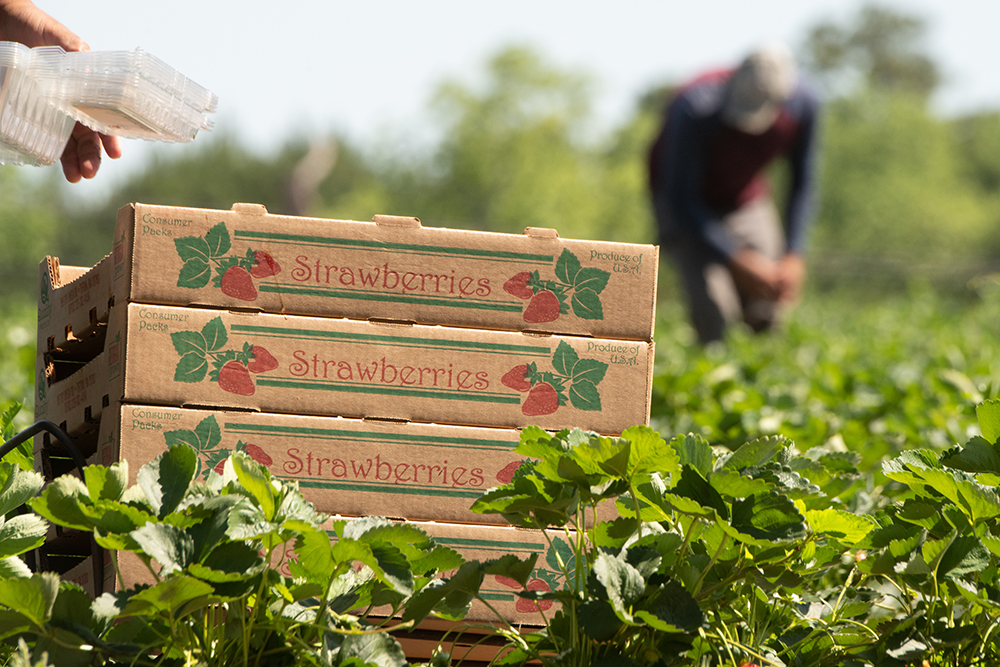
To ensure you’re harvesting crops at the optimal time, learn the ripeness and maturity indicators for the crops you’re growing and train workers to recognize them as well. These indicators are usually when the crop has reached peak ripeness. Some crops, however, such as tomatoes, stone fruit and avocados, should be harvested before they’ve reached peak ripeness, as long as they’re physiologically mature, because they’ll continue ripening in storage. Ask your buyer what level of ripeness they want to receive these crops at. Smaller-scale producers have some advantages over larger operations when it comes to fine tuning the time to harvest, for example by harvesting crops earlier as “baby” vegetables that capture a premium, harvesting at peak ripeness, and harvesting more often to create a steady supply of optimal produce.
If economically feasible, seek out specialized mechanical harvesters for your crops. Hand harvesting allows you to better select for ripe, high-quality produce, but look for tools that make this approach less laborious and more efficient, like hand carts and bins.
Try to settle on a harvesting system that’s efficient, reduces the potential for crop damage and maintains quality. For some crops, such as leafy greens, an approach that allows you to select, sort, trim and package crops in the field can be more efficient, can reduce opportunities for produce to be damaged, and eliminates the need for a packing facility. For other crops, field packing can be challenging to grade your produce and maintain quality control.
Pay attention to other ways you can minimize the risk of damage during and after harvest. A few include:
- Make sure your roads are smooth and trucks have good tires and suspension, to reduce damage from bumping during transport.
- Keep harvested produce out of direct sunlight as much as possible.
- Train workers on how to gently harvest, handle and pack produce.
- To avoid nicking or gouging produce, tools should be sharp but without sharp points, and workers shouldn’t have sharp nails or jewelry on their hands.
For produce that’s damaged, you can explore selling it for processing or using it for your own value-added products. You can also compost it, but make sure you follow best practices so that the composting process destroys pathogens.
Maintaining the Cold Chain
The cold chain refers to the process of removing field heat from crops and keeping them at their ideal storage temperature through all stages from handling, packing and storage through transportation and delivery to a buyer. Meeting the postharvest needs of perishable crops will maximize their shelf life and quality.
Quickly removing the field heat from crops is the most critical aspect of the postharvest cold chain. You’ll want to familiarize yourself with the variety of techniques and equipment used for cooling and refrigeration to determine what will work best for your operation and available resources. Some common approaches to removing field heat include room cooling, forced-air cooling, hydro-cooling and icing, among others.
Regardless of the system used, you can maximize its efficiency by harvesting early in the day when field heat is lower, avoiding direct sunlight on harvested produce, and continuously transferring harvested produce to cooling facilities and refrigerated storage. Trees around your cooling and storage facilities can help shade them, and inside these facilities use low-heat lighting such as LEDs or fluorescent bulbs instead of incandescent or halogen ones. Be prepared to monitor and record temperatures at all stages of the cold chain up to delivery to the buyer.
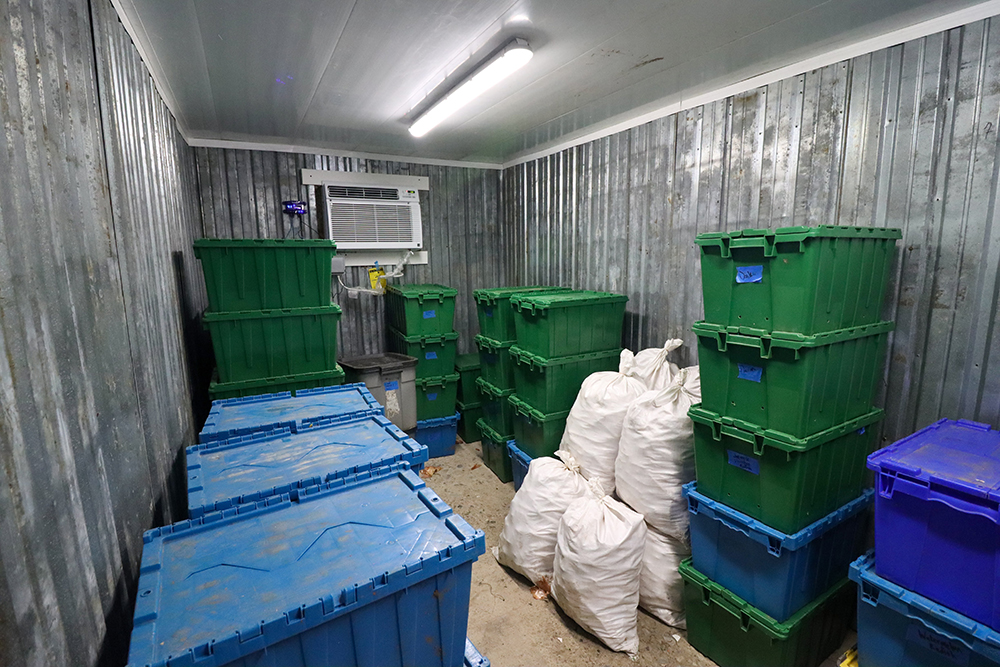

When devising your cooling strategies, be aware of the respiration rate of the crops you’re planning to grow. This rate corresponds to how perishable it is. If you’re planning to grow crops with the highest respiration rates, such as leafy greens, sweet corn or asparagus, they’ll need to be fully cooled quickly after harvest to avoid quality loss. If your ability to cool and refrigerate crops is limited, consider only growing those with low respiration rates, such as tomatoes, potatoes, gourds or melons.
Storage. Along with quickly taking field heat out of heat-sensitive crops, you’ll need well-insulated storage facilities that are maintained at an optimum temperature as part of the cold chain. Generally, minimize the amount of time your produce is kept in storage, and ensure that the produce that’s been in storage the longest is the first to leave when preparing a delivery. Consider how produce is grouped during postharvest storage to avoid unintended damage. Grouping strategies can include:
- Ethylene grouping. Ethylene is a gas released by plants that regulates their growth; certain crops release it after harvest, and it continues their ripening process in a favorable way (for example, apples, bananas and tomatoes). Other crops (green, leafy crops) don’t release ethylene gas and, if they’re exposed to it in storage, will decay more quickly; so don’t store ethylene-producing crops with non-producing ones, and minimize exposure to artificial sources of ethylene, such as cigarette smoke, natural gas and fossil fuel exhaust.
- Cross-transfer of odors. Certain storage combinations should be avoided because one crop will transfer its odor to another in an undesirable way; for example, it’s recommended that onions, nuts, potatoes and citrus be stored separately.
- Temperature and humidity groupings. Many crops can be grouped together based on their optimal temperature and humidity conditions. For example, crops like broccoli, cabbage and carrots have similar temperature and humidity storage requirements (32–35°F and 98–100% humidity).
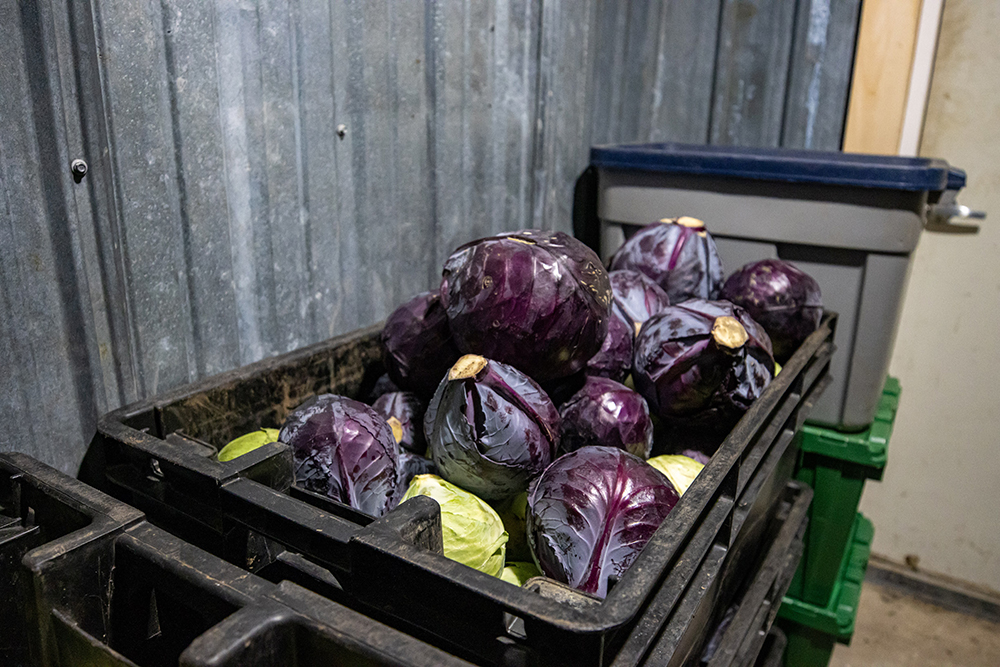
Transport. Cool your trucks before loading and monitor produce temperature during transit. Follow best practices when stacking boxes on pallets and pallets on trucks to promote air flow, maintain cool temperatures and minimize the risk of damage. If you’re making multiple stops, consider installing plastic strip door curtains that help maintain cool temperatures inside the truck door. Consider having a checklist of steps to take before loading each shipment to ensure the truck’s refrigeration system is in good working order, is free of damage or broken seals, and that the temperature is set appropriately for the produce being shipped.
Cleaning, Sorting and Packing
All produce should be clean when shipped, and it’s important to use the correct cleaning process for each type of produce. Cleaning harvested produce is the most labor-intensive stage of production for many crops. If this is the case for your crop, cleaning equipment can be one of the most cost-effective places to invest as you explore your need for mechanized equipment. As with cooling, there are various equipment systems in use for washing and sorting produce. Washing equipment can include barrel washers, pressure washers, wet brush washers and fixed sprayers. Drying may include spinners for greens or screen tables and fans.
Some crops, such as raspberries and strawberries, shouldn’t be washed before marketing, as it will cause mold, bruising and spoilage. Grow these crops using systems that minimize the fruit getting dirty, such as trellising or mulching.
The University of Vermont has free videos of scale-appropriate, cost-effective postharvest cleaning equipment at https://blog.uvm.edu/cwcallah/post-harvest.
When washing produce in water, a sanitizer such as a chlorine-based or peroxyacetic acid product helps to minimize the chance that the water will become contaminated and thus contaminate other produce. Use only food-grade sanitizer products, follow label instructions, and seek out organically approved products as needed. If using a chlorine sanitizer, the pH of wash water needs to be maintained at 6.5–7.5 or the sanitizer efficacy will be reduced. Peroxyacetic-acid-based sanitizers don’t require pH management.
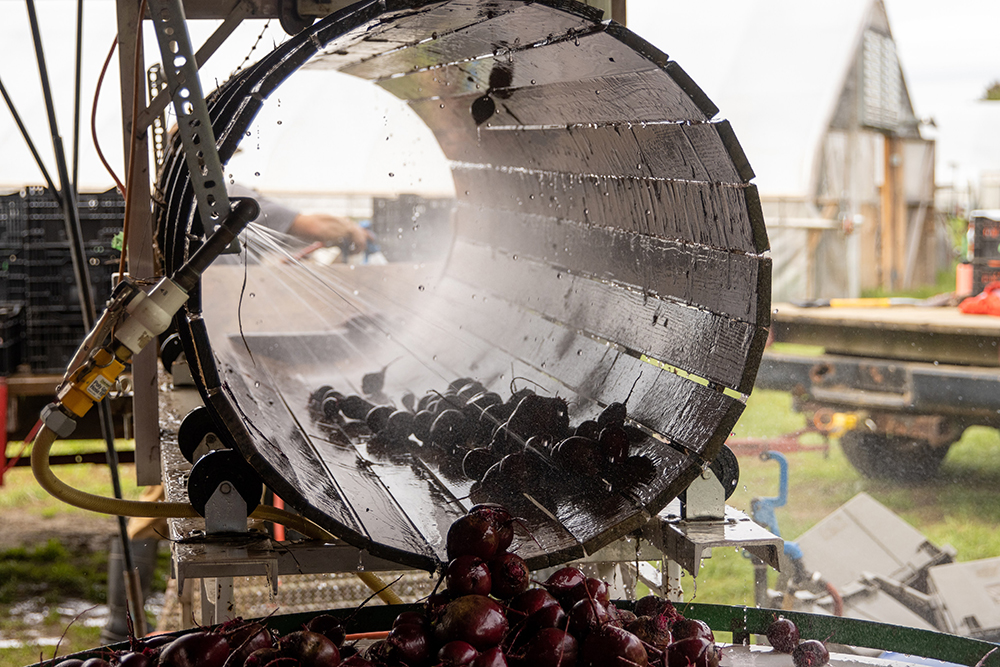
Dunk tanks are the riskiest washing method from a food safety perspective, so consider avoiding them altogether. If you must use dunk tanks, you’ll need to monitor water temperature and maintain it to meet specific produce guidelines. Guidance varies from crop to crop, but generally, the water should be no more than 10° F cooler than the produce’s core temperature to minimize wash water infiltrating into produce during dunking. Some farmers accomplish this by cooling produce before washing it.
Buyers demand consistent quality, quantity, packaging and handling, priorities that tend to be different from your direct market customers. Make sure that workers are well trained to handle produce gently, sort it by grade standards and pack it so that it looks presentable and so that the risk of damage in storage and transit is minimal. Being consistent in how you sort and pack will help you accurately keep track of yields, and this information will help you when planning for the next year.
When sorting produce, presort to remove damaged, diseased or decaying produce. Low-cost sorting equipment such as sizing tables, divergent bars or conveyor belts may be useful, depending on the volume of your produce. Your packing and sorting area should be well designed, taking into account both worker comfort and efficiency. Use standardized packing boxes that are sturdy and have the shape and size suited to the crop so that you can fill them without risking damage to the contents and so that they will stack well on pallets.
Food Safety
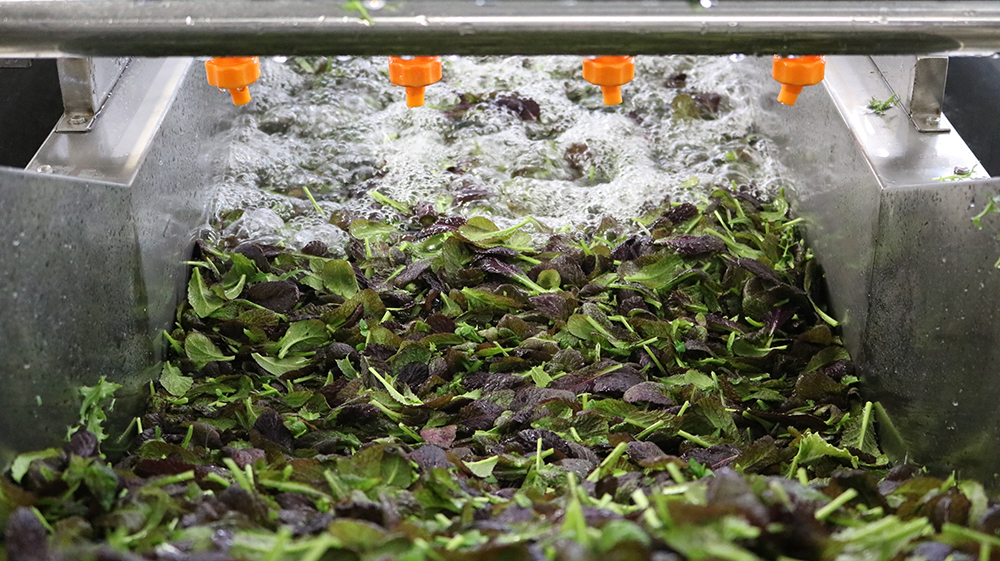
Food safety compliance has received increased attention in recent years, in particular with the passage in 2011 of the Food Safety Modernization Act (FSMA). Many small-scale farms that sell direct to consumers or that wholesale directly to grocers, restaurants and institutions may be exempt from FSMA compliance. Also, FSMA compliance does not require growers to have a written food safety plan or to obtain a third party audit. However, if your aim is to enter wholesale markets, many buyers require growers to have a written food safety plan in place that aligns with Good Agricultural Practices (or GAPs, which are guidelines developed by the USDA and FDA to reduce food safety risks). Buyers may also require farmers to obtain certification by a third party auditor, even if your farm is exempt from FSMA compliance.
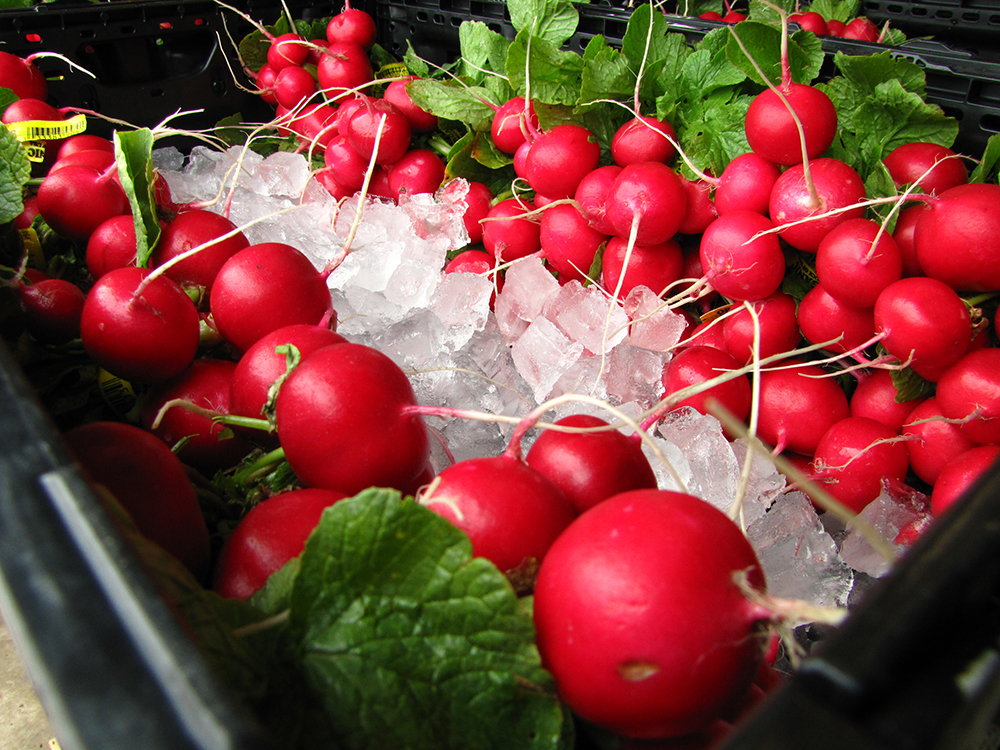
The Produce Safety Alliance at Cornell University provides basic information about food safety plans, GAPs and third party audits in their publication Produce Safety, Audits, and Regulations: A Few Short Question and Answers to Help Fruit and Vegetable Growers.
Broadly, the process of becoming food safety compliant involves understanding what GAPs are, assessing the food safety risks present on your farm, identifying ways to mitigate those risks, continuously monitoring your practices and keeping relevant records. Understanding the guidelines and developing a GAP-compliant plan can seem daunting, but there are many resources available to help. Along with local Extension specialists, good places to start include the Produce Safety Alliance (https://producesafetyalliance.cornell.edu) and the National Good Agricultural Practices Program (https://gaps.cornell.edu/about), which provide FSMA and GAP training resources (respectively) through a collaboration between Cornell University, the USDA and the FDA.
Here’s a summary of the eight principles that underlie the FDA’s guidelines on produce food safety:
- From both a human health and financial perspective, a preventive food safety plan is better than a reactive one that relies on corrective action after microbial contamination has occurred.
- GAPs should be used by growers, packers and shippers in those areas over which they have control.
- Fresh produce can become microbiologically contaminated at any point along the farm-to-table food chain, and major sources of contamination are associated with human or animal feces.
- Water is one of the most common ways that pathogens travel and contaminate produce. All water used on the farm should be carefully monitored because its source and quality dictates the potential for it to contaminate produce that it contacts.
- The use of animal manure or municipal biosolid wastes should be managed closely to minimize food safety risks.
- Workers should follow good hygiene and sanitation practices during production, harvesting, sorting, packing and transport.
- Follow all applicable local, state and federal laws and regulations.
- Qualified personnel and effective monitoring must be in place to implement successful food safety programs and to provide accountability and traceability throughout the food supply chain.
Even though prevention is the main goal of a food safety plan, you’ll want to include a component that identifies an individual or team who will respond to any crises that might arise, as well as a plan for what steps will need to be taken.
Recordkeeping is another important aspect of a food safety plan, one that auditors and usually buyers will require. Records should support all aspects of a plan, for example water quality test results, temperature records in cooling and refrigeration equipment, pest control logs, worker training on hygiene, and logs of when postharvest handling equipment and storage have been cleaned and sanitized.
Resources for Writing a Food Safety Plan
The Produce Safety Alliance at Cornell University provides a Farm Food Safety Plan Template (gaps.cornell.edu/educational-materials/farm-food-safety-plan-template) that addresses dozens of topics and can be tailored to a variety of farming operations. The alliance also offers a list of Extension and industry-specific resources to assist with writing a food safety plan, Farm Food Safety Plan Writing Resources (producesafetyalliance.cornell.edu/resources/farm-food-safety-plan-writing-resources).
